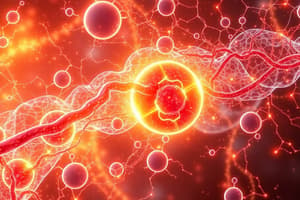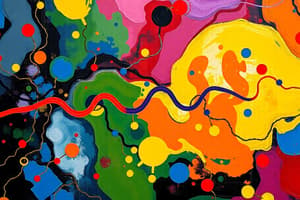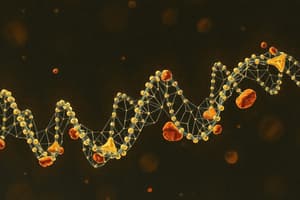Podcast
Questions and Answers
What is the role of the proton gradient created by the electron transport chain?
What is the role of the proton gradient created by the electron transport chain?
- It drives the synthesis of ATP by ATP synthase. (correct)
- It maintains the structural integrity of the mitochondria.
- It helps in the breakdown of glucose.
- It is necessary for the production of NADH.
In the context of ATP synthase, what happens to the γ subunit during ATP synthesis?
In the context of ATP synthase, what happens to the γ subunit during ATP synthesis?
- It rotates in one direction. (correct)
- It remains stationary.
- It disintegrates.
- It hydrolyzes ATP.
What is the final ATP yield from the complete oxidation of one glucose molecule?
What is the final ATP yield from the complete oxidation of one glucose molecule?
- 25 or 27
- 15 or 17
- 18 or 20
- 30 or 32 (correct)
During the well-fed state, what is one of the primary actions of insulin?
During the well-fed state, what is one of the primary actions of insulin?
In a fasting state, what is the primary hormone produced by the pancreas?
In a fasting state, what is the primary hormone produced by the pancreas?
What metabolic process is stimulated by glucagon during fasting?
What metabolic process is stimulated by glucagon during fasting?
What is the purpose of fatty acid breakdown in the fasting liver?
What is the purpose of fatty acid breakdown in the fasting liver?
Which component of the electron transport chain generates a negative electrical potential inside the mitochondria?
Which component of the electron transport chain generates a negative electrical potential inside the mitochondria?
What is the primary function of the chemiosmotic theory in oxidative phosphorylation?
What is the primary function of the chemiosmotic theory in oxidative phosphorylation?
Which complex in the electron transport chain is responsible for utilizing NADH to transfer electrons?
Which complex in the electron transport chain is responsible for utilizing NADH to transfer electrons?
Which of the following correctly describes the role of cytochrome c in oxidative phosphorylation?
Which of the following correctly describes the role of cytochrome c in oxidative phosphorylation?
What ultimately drives the synthesis of ATP during oxidative phosphorylation?
What ultimately drives the synthesis of ATP during oxidative phosphorylation?
Which of the following accurately describes the transfer of electrons through the respiratory chain?
Which of the following accurately describes the transfer of electrons through the respiratory chain?
What is the role of the iron-sulfur proteins in the electron transport chain?
What is the role of the iron-sulfur proteins in the electron transport chain?
How do protons create a proton-motive force across the membrane?
How do protons create a proton-motive force across the membrane?
Which of the following molecules serves as a universal electron acceptor in metabolic pathways?
Which of the following molecules serves as a universal electron acceptor in metabolic pathways?
Flashcards
Chemiosmotic Theory
Chemiosmotic Theory
The theory that explains how energy from electron transport is used to synthesize ATP by harnessing proton gradients.
Electron Transport Chain
Electron Transport Chain
A series of membrane-bound protein complexes that transfer electrons and pump protons across a membrane.
Proton Motive Force
Proton Motive Force
The energy stored in the form of a proton concentration gradient across a membrane.
Complex I
Complex I
Signup and view all the flashcards
Complex II
Complex II
Signup and view all the flashcards
Complex III
Complex III
Signup and view all the flashcards
Complex IV
Complex IV
Signup and view all the flashcards
ATP Synthase
ATP Synthase
Signup and view all the flashcards
What is ATP Synthase?
What is ATP Synthase?
Signup and view all the flashcards
What is the Proton Gradient?
What is the Proton Gradient?
Signup and view all the flashcards
What is Glycogenesis?
What is Glycogenesis?
Signup and view all the flashcards
What is Glycogenolysis?
What is Glycogenolysis?
Signup and view all the flashcards
What is Gluconeogenesis?
What is Gluconeogenesis?
Signup and view all the flashcards
What is Ketogenesis?
What is Ketogenesis?
Signup and view all the flashcards
What is a Lipogenic Liver?
What is a Lipogenic Liver?
Signup and view all the flashcards
What is a Glucogenic Liver?
What is a Glucogenic Liver?
Signup and view all the flashcards
Study Notes
Oxidative Phosphorylation
-
Chemiosmotic Theory: Transmembrane differences in proton concentration are the energy source for biological oxidation-reduction reactions.
-
General Steps:
- Electron flow through a chain of membrane-bound carriers.
- Free energy from this 'downhill' electron flow powers the 'uphill' transport of protons across a membrane.
- Transmembrane proton flow through specific protein channels drives ATP synthesis.
-
Oxidative Phosphorylation Process: Electrons enter the respiratory chain from catabolic pathways.
- Dehydrogenases collect electrons.
- Ubiquinone, cytochromes, and iron-sulfur proteins act as electron carriers.
- Electrons are transferred sequentially, involving changes in oxidation states of iron (Fe3+ to Fe2+), hydrogen atoms (H+ + e-), and hydride ions(:H-).
Complexes I and II
-
Complexes I and II transfer electrons to ubiquinone (Q) from NADH and succinate respectively.
-
Complex III transfers electrons from reduced ubiquinone to cytochrome c.
-
Complex IV completes electron transfer from cytochrome c to oxygen (O2).
Proton-Motive Force
- A proton gradient across the inner mitochondrial membrane is the proton-motive force.
- The difference is described as : ΔG = RT ln (C2/C1) + ZFAψ = 2.3RT ΔpH + FΔψ
Rotational Catalysis
- Conformational changes in ATP synthase are driven by proton passage.
- The y subunit of the Fo portion rotates in one direction during ATP synthesis and in the opposite direction during ATP hydrolysis.
ATP Yield from Complete Oxidation of Glucose
-
Glycolysis: 2 NADH (cytoplasmic), 2 ATP. (Yield is 3 or 5 ATP for cytoplasmic NADH, depending on shuttle).
-
Pyruvate oxidation (per glucose): 2 NADH (mitochondrial matrix). (Yield is 5 ATP).
-
Citric Acid Cycle (per glucose): 6 NADH (mitochondrial matrix), 2 FADH2 , 2 ATP or 2 GTP (Yield is 15 or 18 ATP).
-
Total Yield: 30 or 32 ATP. (Numbers vary based on shuttle system).
Insulin's Effects on Glucose and Lipid Metabolism
-
Metabolic Effects: Insulin regulates blood glucose uptake; glycogen synthesis, glycolysis, and fatty acid synthesis.
-
Target Enzymes: Processes like glucose transport, glucokinase, glycogen synthase, glycogen phosphorylase, and pyruvate dehydrogenase complex are impacted.
-
Triacylglycerol Synthesis: Insulin promotes this process in adipose tissue.
Glucogenic Liver (Fasting State)
- Processes: Gluconeogenesis, glycogenolysis, ketone body formation, protein breakdown.
- Sources of Fuel: Liver uses amino acids, glycerol, and fatty acids to produce glucose and ketone bodies for other tissues.
Studying That Suits You
Use AI to generate personalized quizzes and flashcards to suit your learning preferences.



